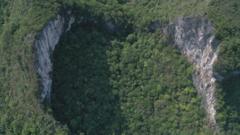
China’s Guangxi province is home to some of the world’s most remarkable geological formations: sinkholes, or “tiankeng” (heavenly pits), which were once feared as supernatural places but are now recognized as extraordinary ecological treasures.
Two-thirds of the world’s over 300 sinkholes are located in China, with Guangxi province hosting 30 of these remarkable formations. These massive cavities are created when underground rivers slowly dissolve limestone, causing the ground to collapse and forming deep, expansive holes at least 100 meters wide and deep.
For centuries, local residents believed these sinkholes were inhabited by demons and ghosts. Fei Ge, a local guide who grew up near these formations, remembers being warned to stay away. However, curiosity eventually led him to explore these mysterious landscapes, discovering their incredible scientific value.
Scientists have found these sinkholes are like time capsules, preserving unique ecosystems untouched for thousands of years. Researchers have discovered previously unknown species, including rare orchids, ghostly white cave fish, and unique spiders and snails. The sinkholes’ isolated environments, protected by steep cliffs and limestone caves, have allowed these organisms to thrive undisturbed.
The discovery of these sinkholes has transformed the region’s economy. Ping’e village, once impoverished, now benefits from tourism. Social media videos showcasing adventurous sinkhole explorations have gone viral, attracting tourists eager to experience these natural wonders.
However, this growing popularity raises concerns about potential ecological damage. Dr. Lina Shen, a leading sinkhole researcher, warns that overdevelopment could threaten these delicate habitats. She suggests alternative tourism approaches like hot air balloons, drone photography, and carefully designed observation pathways that minimize disruption to the ecosystem.
Some sinkholes have already been partially protected. One sinkhole has been closed to tourists to preserve unique orchid varieties. Scientists are also using these formations to study Earth’s environmental changes and climate history.
For adventurers like Rui and Michael, a Shanghai couple, exploring these sinkholes represents an exciting escape from urban life. Equipped with ropes and safety gear, they rappel down sheer cliff faces into lush, prehistoric-looking landscapes, experiencing an environment few humans have ever witnessed.
Brother Fei, now a respected guide, emphasizes the importance of maintaining “clear rules” to protect these natural wonders. He sees the sinkholes as a prized discovery that has not only transformed the local economy but also provided him with a meaningful career connecting tourists and scientists with these extraordinary geological formations.
As tourism grows, the challenge remains balancing human curiosity with ecological preservation, ensuring these “heavenly pits” continue to reveal their secrets while remaining protected for future generations to explore and understand.







